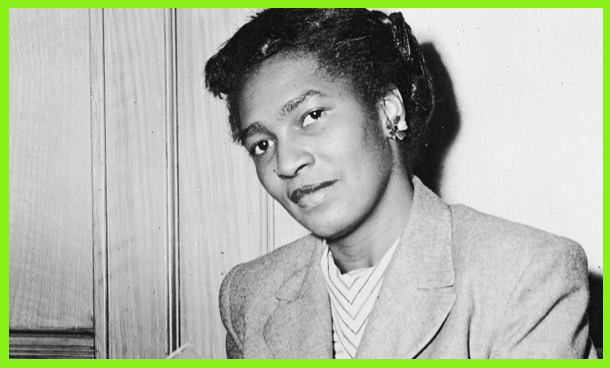✏️ Rachel Thacker
With the announcement that the Notting Hill Carnival will provide an online experience to make up for being cancelled due to Coronavirus, it showcases the importance the celebration has. But the vibrant outfits and the constant music which we associate with the event today, is certainly different to what the experience would’ve been 54 years ago. Still, the fundamentals of showcasing Britain’s multiculturalism has remained constant. Claudia Jones was, a political activist and the founder of the Notting Hill Carnival.

Upbringing
Claudia and her family moved to Harlem, New York when she was 8 in 1923, leaving the life her family knew behind in Port of Spain, Trinidad. Their life was certainly a struggle as her parents faced prejudices preventing them from securing consistent work, their house barely had even the most basic of comforts. Sadly it is no surprise that the family frequently fell ill.
After 5 years of them living in Harlem, unfortunately Claudia’s mother passed away at the age of 37. In later interviews in her life, Claudia commented on how the death of her mother acted as her first realisation of how the degradation and treatment of the black community was costing their lives.
As she attended school, it was clear that she was bright. She won the Theodore Roosevelt Award for Good Citizenship, fuelling her interest in the world of politics and activism. However, her education was fragmented after she was diagnosed with tuberculosis, often having to miss school. Claudia surpassed expectations by graduating and continued to strive to break through societal limitations.
Having a way with words
Claudia worked in unfulling roles as she had no choice but to support her father with an income. And despite her work being unstimulating, Claudia joined a drama group during her spare time, quickly becoming more confident with both her writing and public speaking.
Claudia was then hired in an editorial role for her local newspaper, acting as the starting point to getting her voice heard. Her writing became gradually more political as she established an audience. Her work drove her to become up to date on recent current events which white-washed media outlets were either over-looking or being misleading about.
One of these cases was about the Scottsboro Boys. Nine black teenagers had been falsely accused of rape, they did not recieve a fair trail and were subsequently given the death sentence. Claudia wanted to provide a larger voice for the defendants. Landing herself a role on the Communist Party’s editorial staff, she wrote updates on their appeal and the systematic racism which was being highlighted via the treatment of the Scottsboro Boys.
Claudia continued to use her journalism as an empowering platform, climbing up through the industry until becoming editor of Negro Affairs in 1953. In addition to this, her most famous piece was an essay she wrote titled ‘An End to the Neglect of the Problems of the Negro Woman’ stating that types of oppression don’t exist within isolation, and that movements require the acknowledgment of the toxic mix of discrimination that especially black women faced.
Being a Communist in America
As a result of her charisma and ability to engage people she became an asset to the left political movement. Originally her involvement with the party began with the Young Communist League, and voicing her own experiences with oppression and discrimination.
As her writing became more well read and her public speeches more captivating, her skills were utilised by the larger Communist Party. Touring her around the US to debunk the idea that the group was still only focusing on the progression of working class white men.

McCarthyism is a term coined at the time, meaning the practice of making accusations of subversion or treason without proper regard for evidence. Senator Joseph McCarthy was on a witch hunt for any pro-communist activity. Especially as Claudia had become a public face of the movement and the fact she was black, she was certainly targeted by authorities. They charged her with ‘un-American activities’ which was made harsher due to her being a non-US citizen.
After serving time at the Ellis Island prison, Claudia was to be deported. Originally the plan was to send her back to Trinidad, however they refused to accept her. So instead she was deported to London in 1955
Ally to the Windrush Generation
Claudia’s arrival in the UK coincided with the post-war immigration of people from predominantly the Caribbean. She felt an affinity to their community and immediately got involved in their activism.
From her previous experience within journalism, Claudia created the West Indian Gazette and Afro-Asian Caribbean News. Although Claudia carried out this work above a barbers shop in Brixton. It was an important institute for the community, becoming the first weekly newspaper in the UK. Every week updating people on their rights, how they can receive welfare services and what the current campaigns they could get involved in were.
Racial violence had always been an issue, but it was rising with groups such as Oswald Mosley’s White Defence League invading black communities. Riots broke up and down the country, a notable one being the Notting Hill Riots. It took place over the August bank holiday lasting for a series of five days. Many people were seriously injured and even killed.
Notting Hill Carnival
As a way to regroup her community who were hurting, grieving and having lost so much, Claudia took the unconventional approach of planning a celebration. In a country where they had felt dehumanised and shamed for their culture, she believed it was time to show it’s wonders. As she said: “A people’s art is the genesis of their freedoms.”
The celebration was to include some of their favourite aspects of Caribbean culture; calypso music, steel drums, delicious foods, talents writers and other authentic experiences. It was even televised by the BBC. “Our Carnival symbolises the unity of our people resident here and of all our many friends who love the West Indies’”
Legacy
The Notting Hill Carnival I am sure will have a lasting legacy, it has become a perfect demonstration for the love of diversity in our little country. I hope that the online experience captures all the elements we love, because after all the recent focus on anit-black racism, it will mean so much more.

After a continual struggle with her poor health Claudia Jones died at the age of 47 in 1964. Even after death she caused political confrontation, with her funeral being monitored as a larger political occasion.
For 20 years her grave was unmarked until a Afro-Caribbean Organisation campaigned to raise money for a headstone. But probably what would be most significant to Claudia is that she lays in Highgate Cemetery, to the left of Karl Marx.
Thanks for reading our article! We know young people’s opinions matter and really appreciate everyone who reads us.
Give us a follow on Instagram, Twitter and Facebook to stay up to date with what young people think.

